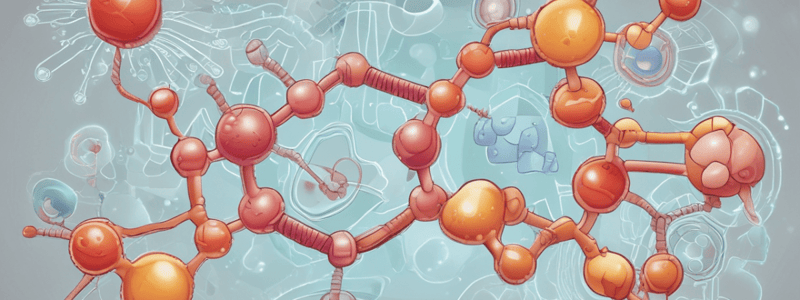Podcast
Questions and Answers
Which enzyme is responsible for the hydrolysis of triacylglycerols in adipose tissue?
Which enzyme is responsible for the hydrolysis of triacylglycerols in adipose tissue?
- Glycerol kinase
- Fatty acid synthase
- Glycerol-3-phosphate dehydrogenase
- Hormone sensitive lipase (correct)
Why does the brain not take up free fatty acids released by lipolysis?
Why does the brain not take up free fatty acids released by lipolysis?
- Lack of specific transporters
- Brain cells do not oxidize fatty acids (correct)
- Inhibition by neurotransmitters
- Absence of glycerol kinase
Which tissue does NOT contain significant levels of glycerol kinase?
Which tissue does NOT contain significant levels of glycerol kinase?
- Kidney
- Intestine
- Liver
- Adipose tissue (correct)
What is produced from glycolysis that is used in the formation of glycerol 3-phosphate in adipose tissue?
What is produced from glycolysis that is used in the formation of glycerol 3-phosphate in adipose tissue?
What essential connection is made by the reaction catalyzed by glycerol-3-phosphate dehydrogenase?
What essential connection is made by the reaction catalyzed by glycerol-3-phosphate dehydrogenase?
What must happen to both fatty acids and glycerol before the formation of triacylglycerol?
What must happen to both fatty acids and glycerol before the formation of triacylglycerol?
Flashcards are hidden until you start studying
Study Notes
Hydrolysis of Triacylglycerol (Lipolysis)
- Triacylglycerols are broken down into fatty acids and glycerol by hormone-sensitive lipase enzyme.
- This breakdown occurs mainly in adipose tissue, releasing free fatty acids into the plasma.
- Free fatty acids are then taken up by tissues (except the brain) to be oxidized or re-esterified.
- Glycerol utilization depends on the presence of glycerol kinase enzyme in tissues such as liver, kidney, intestine, brown adipose tissue, and lactating mammary gland.
Triacylglycerol Biosynthesis
- Triacylglycerols are formed by combining glycerol with three fatty acids.
- The initial step in triacylglycerol formation is the activation of both fatty acids and glycerol.
- Multiple reaction steps follow, ultimately leading to the formation of triacylglycerol.
Activation of Glycerol
- Glycerol kinase enzyme catalyzes the activation of glycerol to glycerol 3-phosphate.
- In the absence or low activity of glycerol kinase enzyme (e.g., in muscle or adipose tissue), glycerol 3-phosphate is formed from dihydroxyacetone phosphate (produced from glycolysis).
- This reaction is catalyzed by glycerol-3-phosphate dehydrogenase enzyme, establishing a crucial connection between carbohydrate and lipid metabolism.
Studying That Suits You
Use AI to generate personalized quizzes and flashcards to suit your learning preferences.




